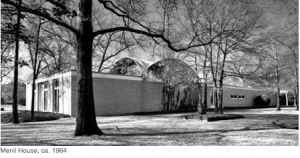Moss: Is decor the glue that hold it all together? Each is segregated—art in galleries and museums, design at showrooms—but we experience it all in a residential context. Most of us live with those subjects fused -- that's the terrain of decorators. Mariano Fortuny was at the intersection of art and designer (painter, photographer, sculptor, architect) -- a true renaissance man. He designed furniture, created one of the first dimmer switches, he was a fashion designer (Delphos gown), and created both functional and non-functional objects. He broke down the guild system, not defining what he was going to be as a single-track career.
deMenil: My background is architecture. Art is something you live with, a relationship that exists in two directions. My mother was a decorator and she taught me how to look at rooms and how they can exist, how you can live with art. I've always considered decorating as a conversation between art and objects.
Moss: Nurturing of the juxtaposition between art and design. It's what I did in my store. At most institutions, like the Metropolitan Museum of Art and MoMA, art and design are separate departments. The Frick will put a chair in front of a painting, but that isn't common practice. Susan's mother-in-law, Dominique de Menil and her husband John commission Philip Johnson in 1948 to build the first International style modern house in Houston. It was his second project after his legendary Glass House.
de Menil: John and Dominique knew the artist/sculptor Mary Calgary, who was a friend of Picasso. They asked Mary who they should work with on their home, and she replied, "For $100,000 you can get Mies; for $75,000, you can get Johnson". Turned down most prominent architect at the time, in a city that was still doing FLW modern, was surprising. But John & Dominique didn't like Philip's furniture suggestions, so he wasn't involved in the interiors. Instead they brought on Charles James, a dress designer, who had done showrooms.
Moss: Bringing in another discipline. He was a sculptor. I used to be in fashion and I'm a big fan of Charles James. Early modernist work of art, in a fairly small home. For a family with a sensibility of art, as inspiration, as something to be used. But "how are we going to live with these things." I just love that Dominique turned to her couturier.
 [A Charles James Butterfly dress, image courtesy Brooklyn Museum]
[A Charles James Butterfly dress, image courtesy Brooklyn Museum]de Menil: Johnson never published the house, because he felt James destroyed his temple to international modernism.The de Menils bought a lot in River Oaks. They wanted the front entrance to be the back entrance. They were very involved in civil rights. The house became an early statement on the treatment of others.

Moss: It positioned Johnson's architecture as a political statement.
Susan: Johnson once told me that Dominique was his greatest client. He felt they introduced him to Houston, where he went on to design the Penzoil building and St Basil's Chapel. They were French, they were living in Houston and they had a family.

[Image courtesy barranca.]
Moss: When I walked in, I said "where's the James"? I was expecting it to look like a dress. It wasn't noticeable to me at first. It seemed like there was bad furniture. A "frugal" approach almost, a diminished approach.
de Menil: James did a dining room banquette, and a living room banquette and chaise, and he selected textiles and colors, and went shopping with them for things they didn't bring from Paris. Primarily, he introduced a palette and textiles, like the greys that they became famous for. The coloring was very subtle, almost European, that wasn't considered modernist at the time.
Moss: And there were five kids in this home. And when you took me to see it, I felt like the home was a loving gesture. I could almost hear Dominique asking Charles "give me a hand with this. Do what your do with dresses in this home." I could see love, tell that it was done by someone intimate with the family, who almost did a favor, like he wasn't wanting to offend Johnson. The Cupboards were painted on the interiors. The kids bedroom doors are covered with velvet and felt, there's a velvet curtain leading to the bathroom instead of a door. Gestures that weren't integrated into the architecture. The architecture and the interiors were kept disparate-- you can tell what's the James and what's the Johnson.
de Menil: I'm sure they were tough clients. They certainly knew what they wanted. But there was an impulse that was informed by what they knew, and they didn't care what the "canon" said, they refused to have the Barcelona chairs. They wanted to make Houston more cosmopolitan and they did it in their home.

[Mies van der Rohe's Barcelona chair, image courtesy of Knoll.]
Moss: James wasn't creating a holistic environment. It wasn't a montage, a layering or overlaid. This is two distinct realms. Is it possible to have a good decor without art? Susan lives with great art. And tell them about your daughter's 16th birthday party. They made a decision to remove art from some of the rooms.
de Menil: The harsh reality of having 60 16 year-olds in your home. My husband was the architect of the house, and we removed the art from the first two floors. We left the furniture and the rug, and there was just a piano and picture hooks.
Moss: And it really looked fabulous. The architecture, the colors, the light, proportions are artful elements and they held their own, but when the art was up, because it's so good, it absorbed you, not letting you get to the architecture. When you take out the most important things, you can see the rest of the underlying layers. The house I grew up in was a suburban Chicago dream house. But my parents were industrialists--my dad wanted a drinking fountain in the dining room, and hand-driers in the bathroom. Robert Mellon was our decorator, and he had the opposite job of de Menil. He made a kumquat garden in the dining room for our petal drinking fountain. My mother wanted the pink bathroom, green bathroom, so Mellon enameled the hand driers! The point is there are disparate situations when it comes to decor. And different opinions and personalities involved. I was at a house in the Hampton and there was this enormous tree, and the architect said it had to be cut, because it was covering too much of the house. Are we meant to live with art, and when we do, does it have to become functional?
de Menil: You don't have to have great art, but you need to know how to present it in the room, how you install it.
Moss: I think decor is an art, one which isn't institutionally supported. There's no sanctioned model. It's almost impolite to talk about, but yet it's critical. There's an inherent juxtaposition of functional and non-functional, and yet one needs to come first. Decor is about gluing it all together. Art can be experienced on its own, but it can't service you in how you want to live. Is decor always about personal expression or status? It's a complicated question. Each piece works together but doesn't lose its integrity with its relation to what surrounds it.
Moss: There's no rule that you have to live with balance. It's ok to say "I don't care." And invest and show off what you care about. A Rietveld zigzag chair isn't merely a functional object. But at the end of the day, art and design are seen together in a home. But they can be mutually beneficial. Wouldn't a Rothko benefit from being seen with equally "valuable" furnishings.
de Menil: God is in the details.

Moss: There are things that a painting can't do. You can't drink out of a painting. There's a physical interaction with design. I love very fragile glass [like Lobmeyr, pictured above, available through Moss]- $200 a piece- and you have an altered behavior when you use it because it's delicate. It's experiential. That's incredible value for $200.

No comments:
Post a Comment